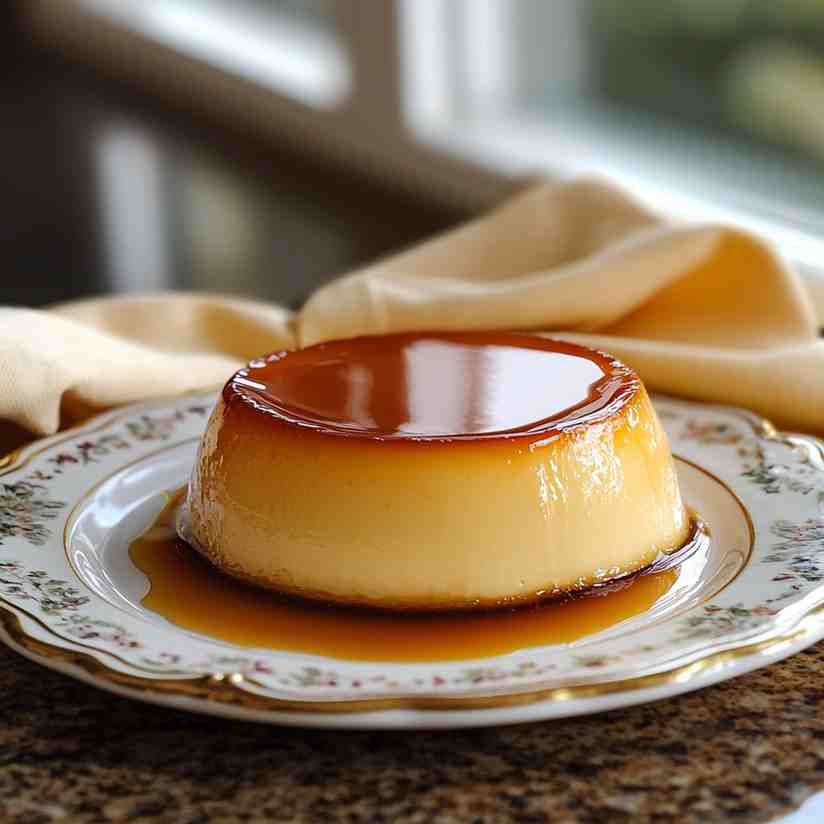Flan, a beloved caramel custard dessert, has captivated taste buds worldwide with its silky texture and rich flavor. This comprehensive guide delves into the origins of flan, explores its diverse regional variations, and provides a detailed recipe accompanied by expert tips to help you craft the perfect flan at home.
A Brief History of Flan
Flan’s origins trace back to ancient Rome, where an abundance of eggs led to the creation of various egg-based dishes. The Romans developed a custard-like concoction made from eggs, milk, and honey. As the Roman Empire expanded, this dish spread throughout Europe. In Spain, flan evolved into a sweet dessert featuring a caramelized sugar topping. Spanish explorers later introduced flan to the Americas, where it became a cherished treat in many Latin American countries.
Regional Variations
Flan’s adaptability has resulted in numerous regional interpretations, each adding a unique twist to the classic dessert:
- Mexican Flan: Often incorporates cream cheese, resulting in a richer, denser texture.
- Filipino Leche Flan: Utilizes more egg yolks and condensed milk, yielding a creamier consistency.
- French Flan Pâtissier: Features a pastry crust filled with vanilla-infused custard, offering a delightful contrast between flaky crust and smooth filling.
- Venezuelan Quesillo: Characterized by its distinctive hole-riddled appearance, achieved by blending the mixture to incorporate air before baking.
Ingredients
To prepare a classic flan, you’ll need:
For the Caramel:
- 1 cup granulated sugar
- 1/4 cup water
For the Custard:
- 4 large eggs
- 2 large egg yolks
- 1 (14-ounce) can sweetened condensed milk
- 1 (12-ounce) can evaporated milk
- 1 tablespoon vanilla extract
- 1/4 teaspoon salt
Equipment Needed
- Saucepan: For caramelizing sugar.
- Mixing Bowls: To combine custard ingredients.
- Whisk: Ensures a smooth mixture.
- 8-inch Round Baking Dish: To hold the flan.
- Roasting Pan: To create a water bath during baking.
- Fine-Mesh Strainer: For a silky custard texture.
- Aluminum Foil: To cover the flan during baking.
Step-by-Step Instructions
1. Prepare the Caramel:
- In a medium saucepan over medium heat, combine 1 cup of granulated sugar and 1/4 cup of water. Cook without stirring until the mixture turns a deep amber color, approximately 10-12 minutes.
- Immediately pour the caramel into an 8-inch round baking dish, tilting to coat the bottom evenly. Allow it to harden.
2. Prepare the Custard:
- In a large mixing bowl, whisk together 4 large eggs and 2 large egg yolks until fully combined.
- Add the sweetened condensed milk, evaporated milk, vanilla extract, and salt. Mix until smooth and homogeneous.
3. Combine and Strain:
- Pour the custard mixture through a fine-mesh strainer into the caramel-coated baking dish. This step ensures a silky texture by removing any lumps or air bubbles.
4. Prepare the Water Bath:
- Place the filled baking dish into a larger roasting pan. Add hot water to the roasting pan until it reaches halfway up the sides of the baking dish. This water bath promotes even cooking and prevents the custard from curdling.
5. Bake:
- Preheat the oven to 350°F (175°C). Carefully transfer the roasting pan to the oven.
- Bake for approximately 50-60 minutes, or until the flan is set but still slightly jiggly in the center.
6. Cool and Refrigerate:
- Remove the baking dish from the water bath and let it cool to room temperature.
- Once cooled, cover with plastic wrap and refrigerate for at least 4 hours, preferably overnight. Chilling allows the flan to firm up and enhances its flavor.
7. Unmold and Serve:
- Run a knife around the edges of the flan to loosen it from the baking dish.
- Place a serving plate over the baking dish and invert quickly. The flan should release onto the plate, with the caramel sauce flowing over the top.
- Slice and serve chilled.
Expert Tips for Perfect Flan
- Caramelization: Monitor the sugar closely while caramelizing. Aim for a deep amber hue; overcooking can result in a bitter taste.
- Smooth Custard: Strain the custard mixture to eliminate any lumps, ensuring a silky texture.
- Water Bath: Always use a water bath to maintain gentle, even heat, preventing the custard from curdling.
- Avoid Overbaking: The center should remain slightly jiggly when removing from the oven, as it will continue to set while cooling.
- Chilling: Allow ample refrigeration time for the flan to firm up and develop its characteristic texture and flavor.
Common Mistakes to Avoid
- Skipping the Straining Step: Failing to strain the custard mixture can lead to a grainy texture.
- Neglecting the Water Bath: Without a water bath, the flan may cook unevenly, resulting in a less desirable texture.
- Overcaramelizing Sugar: Burnt caramel imparts a bitter flavor; remove from heat once a deep amber color is achieved.
By following this guide, you can master the art of making flan, delighting yourself and others with this timeless dessert.

